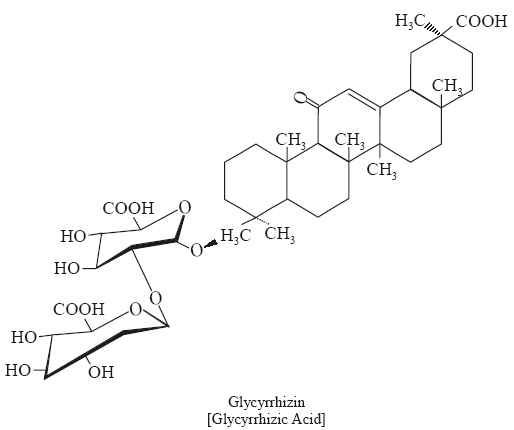2.8.2.2 Liquorice
Synonyms Glycyrrhiza;
Liquorice root; Glycyrrhizae radix.
Biological Sources Liquorice
is the dried, peeled or unpeeled, roots, rhizome or stolon of Glycyrrhiza
glabra Linn., invariably known in commerce as Spanish liquorice, or of Glycyrrhiza
glabra Linne. var Glandulifera Waldstein et Kitaibel, mostly
known in commerce as Russian liquorice, or of other varieties of Glycyrrhiza
glabra Linne., which produce a sweet and yellow wood, belonging to family Leguminosae.
The word Glycyrrhiza has
been derived from the Greek origin that means sweet root; and glabra means
smooth and usually refers to the smooth, pod-like fruit of this
particular species. Nevertheless, the fruits of the glandulifera variety
has a distinct gland like swellings.
Geographical Sources
Liquorice is grown in the sub-Himalayan tracts and Baluchistan. It is cultivated
on a large scale in Spain, Sicily and Yorkshire (England) G. glabra var violaceae
is found in Iran; whereas G. glabra var glandulifera exclusively
grows in Russia (the ‘Russian Liquorice’).
The following are the three commonly
grown varieties of Glycyrrhiza glabra, namely:
(a) G. glabra var.
violaceae (or Persian Liquorice): This specific species bears
violet flowers,
(b) G. glabra var
gladulifera (or Russian Liquorice): It has a distinct big stock
together with a number of elongated roots, but it has not got any stolon, and
(c) G. glabra var.
typica (or Spanish Liquorice): This specific plant bears only
purplish-blue coloured papilionaceous flowers. It possesses a large number of
stolons.
Preparation The roots
are usually harvested after 3 to 4 years from its plantation when they mostly
display enough growth. The rhizomes and roots are normally harvested in the
month of October, particularly from all such plants that have not yet borne the
fruits. thereby ascertaining maximum sweetness of the sap. The rootlets and
buds are removed manually and the drug is washed with running water. The drug
is first dried under the sun and subsequently under the shade till it loses
almost 50% of its initial weight. The large thick roots of the Russian
Liquorice are usually peeled before drying. It is an usual practice in Turkey,
Spain and Israel to extract a substantial quantity of the drug with water, the
resulting liquid is filtered and evaporated under vacuo and the concentrated
extract is molded either into sticks or other suitable forms.
Description
Colour : Unpeeled
Liquorice-Externally, yellowish brown or dark brown; and internally, yellowish
colour
Odour : Faint and
characteristic
Taste : Sweet
Size : Length = 20 to 50
cm; Diameter = 2 cm
Shape : Unpeeled drug—Straight
and nearly cylindrical
Peeled drug—Mostly
angular
Fracture : Fibrous in
bark; and splintery in the wood.
Chemical Constituents
Glycyrrhiza (liquorice) comprises of a saponin like glycoside known as glycyrrhizin
(or glycyrrhizic acid) as shown below:
Glycyrrhizin is found to
be 50 times as sweet as sugar. Glycyrrhizin upon hydrolysis loses its sweet
taste and gives rise to the aglycone glycyrrhetinic acid (glycyrrhetic
acid) together with two moles of glucuronic acid. The former is a
pentacyclic triterpene derivative of the b amyrin type. A host of other
chemical constituents essentially include are namely: coumarin derivatives e.g.,
umbelliferone and herniarin; flavonoid glycoside e.g.,
liquiritoside; isoliquiritoside, liquiritin; isoliquiritin,
rhanoliquiritin, and rhamnoisoliquiritin; asparagine;
22-33-dihyrostigmasterol; glucose; mannitol and about 20% of
starch. Interestingly, carbenoxolone, which is an oleandane
derivative is prepared from glycyrrhiza and possesses considerable mineralocorticoid
activity. It is used as an anti-ulcer drug.
Chemical Tests
1. When sulphuric acid (80%) is
added to a thick section of the drug or powder, it instantly produced a deep
yellow colour.
Substituents/Adulterants Glycyrrhiza
uralansis, also known as Manchurian Liquorice, which is pale chocholate
brown in appearance having wavy medullary rays and exfoliated cork is mostly used
as an adulterant for G. glabra. This particulr species is from sugar,
but contains glycyrrhizin. Sometimes, the Russian Liquorice is
also used as an adulterant, because the drug is purplish in appreance, has long
roots but having no stolons.
Uses
1. Glycyrrhiza has
demulscent and expectorant properties
2. It is used as a masking
agent for bitter drugs in pharmaceutical formulations, such as: quinine, aloe,
ammonium chloride etc.
3. Ammoniated glycyrrhiza is
employed as a flavouring agent in beverages, pharmaceuticals and confectionary.
4. The inherent surfectant
activity due to the presence of saponins helps to facilitate the absorption of
poorly absorbed drugs, for instance: anthraquinone glycosides.
5. It is invariably added to
beer to form stable and enhanced foaminess.
6. It imparts a distinct and
characteristic bitter tastte to a number of beverages, such as: stout, root beer
and porter.
7. The presence of glycyrrhetinic
acid exert mineralocorticoid activity and hence it is used in the treatment
of inflamations, rhematoid arthritis and Addison’s disease.
8. Liquorice is an
important ingredient in ‘Liquorice compound powder’ wherein it augments the
action of senna.
9. Liquorice liquid extract is
employed as a foam stabilizer in the foam type-fire-extinguisher.
10. Liquorice liquid extract
is used in the treatment of peptic ulcer.
11. In Europe the glycyrrhetic
acid is employed exclusively in dermatological formulations for its remarkable
antiinflammatory properties.
Caution As glycyrrhzin
appreciably enhances sodium and fluid retention and promotes potassium
depletion. Therefore, patients with history of either cardiac problems or hypertension
must avoid consumption of signficant amount of liquorice.
Source: Pharmacognosy And Pharmacobiotechnology By Ashutosh Kar
Source: Pharmacognosy And Pharmacobiotechnology By Ashutosh Kar




1 Comment:
Help me a lot for my lab report. :)
Post a Comment